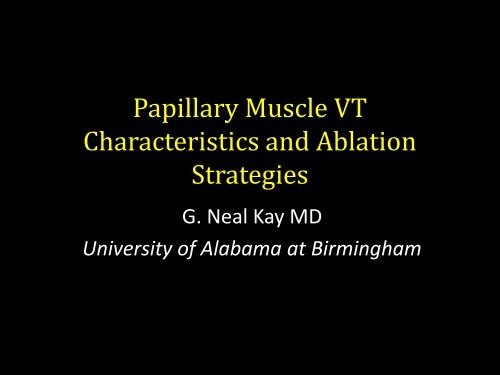Kay-Papillary-Muscle-VT
Kay-Papillary-Muscle-VT Kay-Papillary-Muscle-VT
Papillary Muscle VTCharacteristics and AblationStrategiesG. Neal Kay MDUniversity of Alabama at Birmingham
- Page 3 and 4: Posteromedial Papillary Muscle VT
- Page 5 and 6: Intracardiac Recordings
- Page 7 and 8: Doppalapudi H, et al Circ Arrhythm
- Page 9 and 10: Doppalapudi H, et al Circ Arrhythm
- Page 11 and 12: Anterolateral Papillary Muscle VT
- Page 13 and 14: Characteristics of PM VT• Total S
- Page 15 and 16: Papillary MusclesAnterior (lateral)
- Page 17 and 18: Posterior Half of LVLateral PMPoste
- Page 19 and 20: Posterior Papillary Muscle
- Page 21 and 22: Anterior (Lateral) Papillary Muscle
- Page 23 and 24: Posterior Papillary Muscle VT
- Page 25 and 26: Posterior Papillary Muscle VT
- Page 29 and 30: Left Anterior Papillary MuscleMore
- Page 31 and 32: Intracardiac EchoLiu X, et al. Hear
- Page 33 and 34: 3D Echo of Papillary Muscles
- Page 35 and 36: PPM Delayed EnhancementGood E, et a
- Page 37 and 38: DE of Papillary Muscles in SarcoidS
- Page 39 and 40: Evidence for a Deep Focal Mechanism
- Page 41 and 42: Intracardiac Echo1 st Ablation 2nd
- Page 44 and 45: Why Multiple Exits?Madhavan M. and
- Page 46 and 47: Incessant VT after Inferior MIYamad
- Page 48 and 49: Posterior Papillary Muscle VT
- Page 50 and 51: Reentrant LV VTNogami A, et al. JAC
<strong>Papillary</strong> <strong>Muscle</strong> <strong>VT</strong>Characteristics and AblationStrategiesG. Neal <strong>Kay</strong> MDUniversity of Alabama at Birmingham
Posteromedial <strong>Papillary</strong> <strong>Muscle</strong> <strong>VT</strong>
Posterior <strong>Papillary</strong> <strong>Muscle</strong> <strong>VT</strong>Clinical CharacteristicsDoppalapudi H, et al Circ Arrhythm EP 2008; 1:23
Intracardiac Recordings
Doppalapudi H, et al Circ Arrhythm EP 2008; 1:23
Doppalapudi H, et al Circ Arrhythm EP 2008; 1:23
Doppalapudi H, et al Circ Arrhythm EP 2008; 1:23
Doppalapudi H, et al Circ Arrhythm EP 2008; 1:23
Reversible CM from PM PVCsBaselineIsoproterenolSternick E, et al. JICE 2009;25:67.
Anterolateral <strong>Papillary</strong> <strong>Muscle</strong> <strong>VT</strong>
Characteristics of PM <strong>VT</strong>• 387 consecutive patients with idiopathic LV VAs• Site of origin– Aortic root 210 (54.3%)– Aorto-mitral continuity 23 (5.9%)– Epicardial LV 41 (10.6%)– Mitral annulus 43 (11.1%)– Fascicular <strong>VT</strong> 29 (7.5%)– Anterior (Lateral) PM 17 (4.4%)– Posterior PM 24 (6.2)%
Characteristics of PM <strong>VT</strong>• Total Series 41 patients with Idiopathic PM <strong>VT</strong>• 31 men and 10 women• Age 34 to 82 years (mean 59±14 years)• LVEF= 0.63±0.06• No structural heart disease in 37 pts• AVR in 1 pt• HOCM in 3 pts
Characteristics of PM VAs• Sustained <strong>VT</strong> 22 pts• NS<strong>VT</strong>8 pts• Frequent PVCs 11 pts• Exertional worsening of VAs in 27 pts• Generally benign clinical course– No pt suffered from cardiac arrest or syncope– Duration of symptoms 1 month to 9 years
<strong>Papillary</strong> <strong>Muscle</strong>sAnterior (lateral) PMPosterior (inferior) PM
Section Through LVAnteriorPosterior
Posterior Half of LVLateral PMPosterior PM
APMAPMPPMPPM
Posterior <strong>Papillary</strong> <strong>Muscle</strong>
Posterior <strong>Papillary</strong> <strong>VT</strong>
Anterior (Lateral) <strong>Papillary</strong> <strong>Muscle</strong>
Echo and Posterior <strong>Papillary</strong> <strong>Muscle</strong> <strong>VT</strong>Apical in LVBasal on PM
Posterior <strong>Papillary</strong> <strong>Muscle</strong> <strong>VT</strong>
Posterior <strong>Papillary</strong> <strong>Muscle</strong> <strong>VT</strong>
Posterior <strong>Papillary</strong> <strong>Muscle</strong> <strong>VT</strong>
Anterior <strong>Papillary</strong> <strong>Muscle</strong>
Left Anterior <strong>Papillary</strong> <strong>Muscle</strong>More Basal in LVMore Apical on PM
Anterior <strong>Papillary</strong> <strong>Muscle</strong>
Intracardiac EchoLiu X, et al. Heart Rhythm 2008;5:479
Figure 1.APMPPMAPMAPMPPMPPM
3D Echo of <strong>Papillary</strong> <strong>Muscle</strong>s
MRI Delayed Enhancement of PPMBogun F, et al. JACC 2008;51:1794.
PPM Delayed EnhancementGood E, et al. Heart Rhythm 2008;5:1530
Anterior PM <strong>VT</strong> in SarcoidosisSato Y, et al. International J Cardiol 2008;130:288
DE of <strong>Papillary</strong> <strong>Muscle</strong>s in SarcoidSato Y, et al. International J Cardiol 2008;130:288
Overdrive Suppression and Multiple Exit SitesLiu X, et al. Heart Rhythm 2008;5:479
Evidence for a Deep Focal MechanismIntermittent Exit BlockComplete Exit BlockLiu X, et al. Heart Rhythm 2008;5:479
Lateral and Medial Exits
Intracardiac Echo1 st Ablation 2nd AblationSeiler J, et al. Heart Rhythm 2009;6:389
Different Exits of PM <strong>VT</strong>
Why Multiple Exits?Madhavan M. and Asirvatham S. Circ Arr EP 2010;3:302.
Epicardial Mapping over Lat PM
Incessant <strong>VT</strong> after Inferior MIYamada T, et al. JICE 2009;24:143.
Posterior <strong>Papillary</strong> <strong>Muscle</strong> <strong>VT</strong> After MI
Posterior <strong>Papillary</strong> <strong>Muscle</strong> <strong>VT</strong>
<strong>Papillary</strong> <strong>Muscle</strong> Ablation SitesGood E, et al. Heart Rhythm 2008;5:1530
Reentrant LV <strong>VT</strong>Nogami A, et al. JACC 2000;36:811.
Fascicular Reentrant LV-<strong>VT</strong>Nogami A, et al. JACC 2000;36:811.
Proposed Mechanism of Reentrant <strong>VT</strong>Nogami A, et al. JACC 2000;36:811.
Ablation of Reentrant LV-<strong>VT</strong>
Mitral Annular <strong>VT</strong>
Aorto-Mitral Continuity
Aorto-Mitral Continuity
Fascicular PVCs
Posterior <strong>Papillary</strong> <strong>Muscle</strong> <strong>VT</strong> and Fascicular <strong>VT</strong>s
Anterior <strong>Papillary</strong> <strong>Muscle</strong> <strong>VT</strong> and Fascicular <strong>VT</strong>s
The Segments of the RVRight ViewLeft ViewRCCLCCRCCMBParBandLCCNCCAnt Pap Ms
RV Internal AnatomyAnteriorLeft LateralModBandInfPap MPost Pap <strong>Muscle</strong>Ant Pap <strong>Muscle</strong>
Septal <strong>Papillary</strong> <strong>Muscle</strong>
RV Septal PMRV Posterior PMCrawford T, et al.Heart Rhythm2010;7:725
RV Posterior PMCrawford T, et al.Heart Rhythm2010;7:725
Pacemap RV Posterior PMCrawford T, et al. Heart Rhythm 2010;7:725
RV <strong>Papillary</strong> <strong>Muscle</strong> Ablation SitesCrawford T, et al. Heart Rhythm 2010;7:725
Idiopathic Epicardial Crux <strong>VT</strong>
Crux Ablation Site
Epicardial RV
Intramural PVCPVC 1 PVC 2
PacemappingEndocardial PacingSpontaneous
Best Endocardial and Epicardial Sites
Endocardial and Epicardial Mapping-18 ms -19 msGreat Cardiac VeinEndocardial LV
Combined Endo-Epi Ablation
Intramural SeptumDanger ZoneSeptal arterySeptal vein
Best Epicardial LV SiteNear LADRAOLAO
Best Epicardial RV SiteNear LADRAOLAO
Occluded Distal LCxAfter RF
Coronary Arteries Can be Injured by RF inNearby Veins
Conclusions• <strong>VT</strong> and PVCs may arise from either the PPM or theAPM in the LV and any of the 3 PMs in the RV• <strong>VT</strong> is often exercise induced and may require IVepinephrine to induce• Variation in QRS morphology occurs in approximately50% of pts• The mechanism is focal and not reentry• Purkinje Fibers may be activated early but do notappear the site of origin• The PMs may be relatively spared after MI and be thesite of incessant <strong>VT</strong>
Conclusions• The site of origin appears to be within the PMitself and exit sites are often multiple• The PMs are the thickest structures in the entireheart• Ablation is challenging with frequent changes inactivation after RF applications• High energy RF is usually required with severalRF applications to achieve success• The recurrence risk is higher than for other formsof idiopathic <strong>VT</strong>



